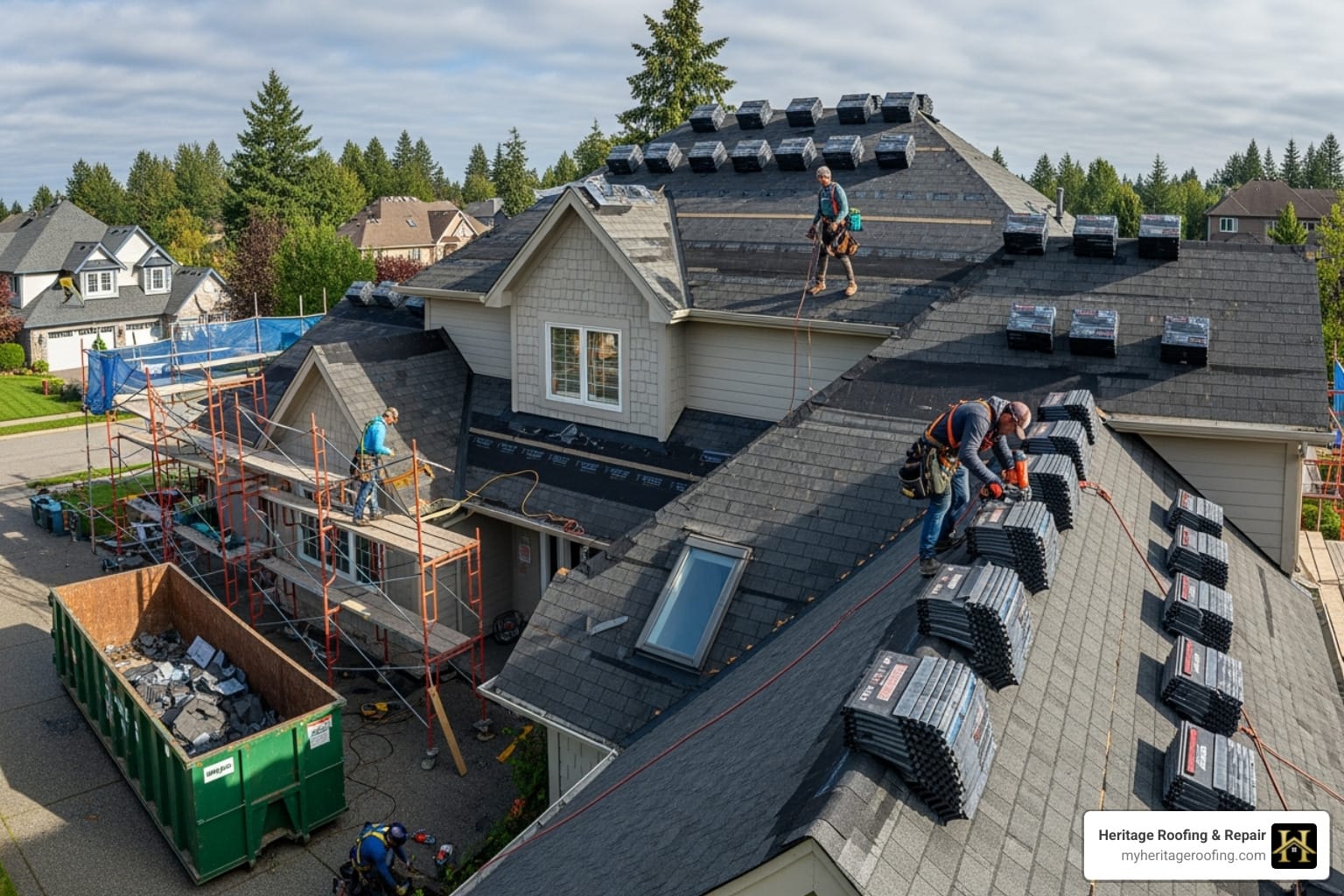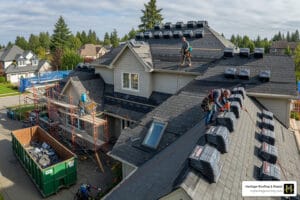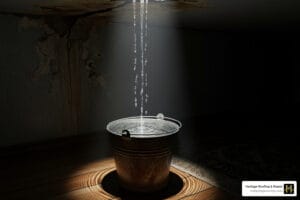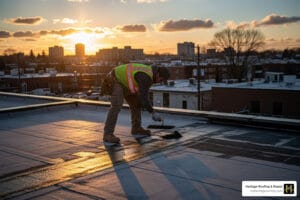Why Understanding Your Roof Replacement Options Matters
Roof replacement for homeowners is a major decision that affects your home’s safety, value, and comfort for decades. With the average asphalt shingle roof lasting only 15 to 18 years, many homeowners underestimate their roof’s age, leading to unexpected and costly problems. Making an informed choice starts with understanding your options, a process our team at Heritage Roofing & Repair has guided Northwest Arkansas homeowners through for over 50 years.
Key considerations for homeowners planning a roof replacement:
- Cost factors: Size, materials, complexity, and labor typically range from $6,700 to $80,000.
- Material options: Asphalt shingles ($7,300-$10,600), metal roofing ($27,500-$42,300), or tile ($33,700-$69,800).
- Insurance coverage: Storm damage may be fully covered under Replacement Cost Value (RCV) policies.
- Contractor selection: Choose licensed, local roofers with manufacturer certifications.
- Timeline: Plan for moderate weather seasons to avoid installation issues.
Whether you’re dealing with storm damage, aging shingles, or persistent leaks, this guide covers everything from recognizing warning signs to choosing the right contractor for your professional roof replacement.
I’m Rex Wisdom, owner of Heritage Roofing & Repair. For over 50 years, my family has helped homeowners in Northwest Arkansas with honest advice and quality craftsmanship. We’ll walk you through every step to ensure your investment protects your home for years to come.
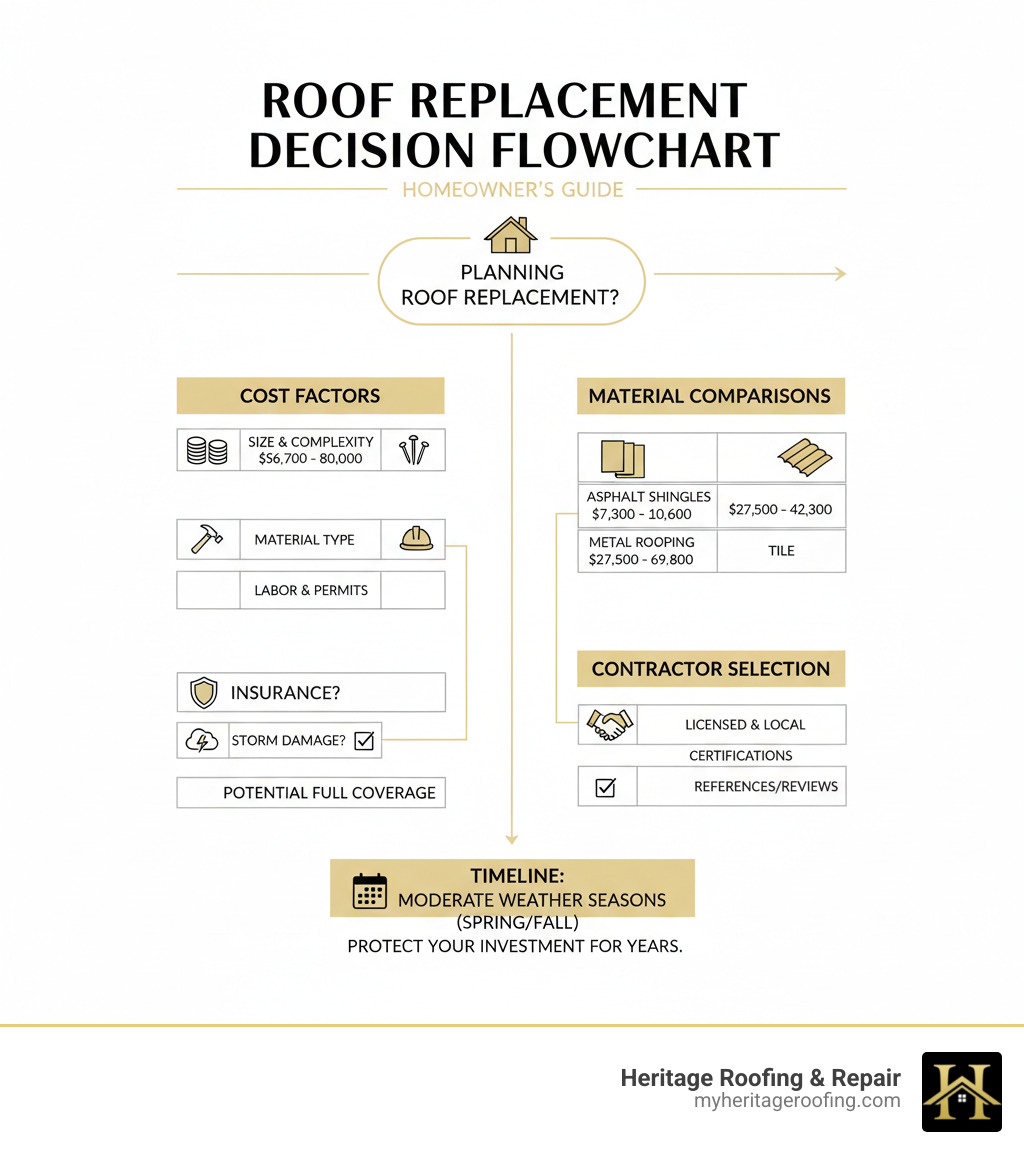
Roof replacement for homeowners terms made easy:
- average roof replacement cost
- best residential roofing replacement services
- best residential roof replacement
Is It Time for a New Roof? 7 Telltale Signs to Watch For
Your roof works hard to protect your home, but it’s easy to forget it’s there until something goes wrong. Since the average asphalt shingle roof only lasts 15 to 18 years, it’s crucial to know the warning signs that a professional roof replacement is on the horizon. Catching problems early can save you from expensive disasters like water damage, mold, or structural issues.
Here are seven clear signs that it might be time for a new roof:
- Curling or Cracked Shingles: When shingles curl at the edges, cup in the middle, or show cracks, they have lost their ability to shed water effectively. This is a common sign of aging from years of sun exposure.
- Missing Shingles: Strong winds can tear off shingles, leaving your roof’s underlayment exposed to rain and UV rays. Even a few missing shingles can create entry points for water.
- Granules in Gutters: Asphalt shingles are coated in granules that protect them from the sun. If you find large amounts of these granules in your gutters, it means your shingles are losing their protective layer and deteriorating.
- Ceiling Leaks or Water Stains: Brown or yellow stains on your ceiling or walls are an emergency alert. This means water has already breached your roof and is causing damage inside your home.
- A Sagging Roof Deck: A dip or curve in your roofline is a serious red flag indicating potential rot in the decking or structural supports. This almost always requires a full replacement.
- Widespread Moss or Algae Growth: While a little green can be cleaned, thick moss or extensive algae traps moisture against your roof, causing shingles to lift and deteriorate faster.
- Your Roof’s Age: If your asphalt shingle roof is over 15 years old, its protective qualities are declining, even if it looks fine from the ground. An aging roof is more vulnerable to storm damage and may not qualify for full insurance coverage.
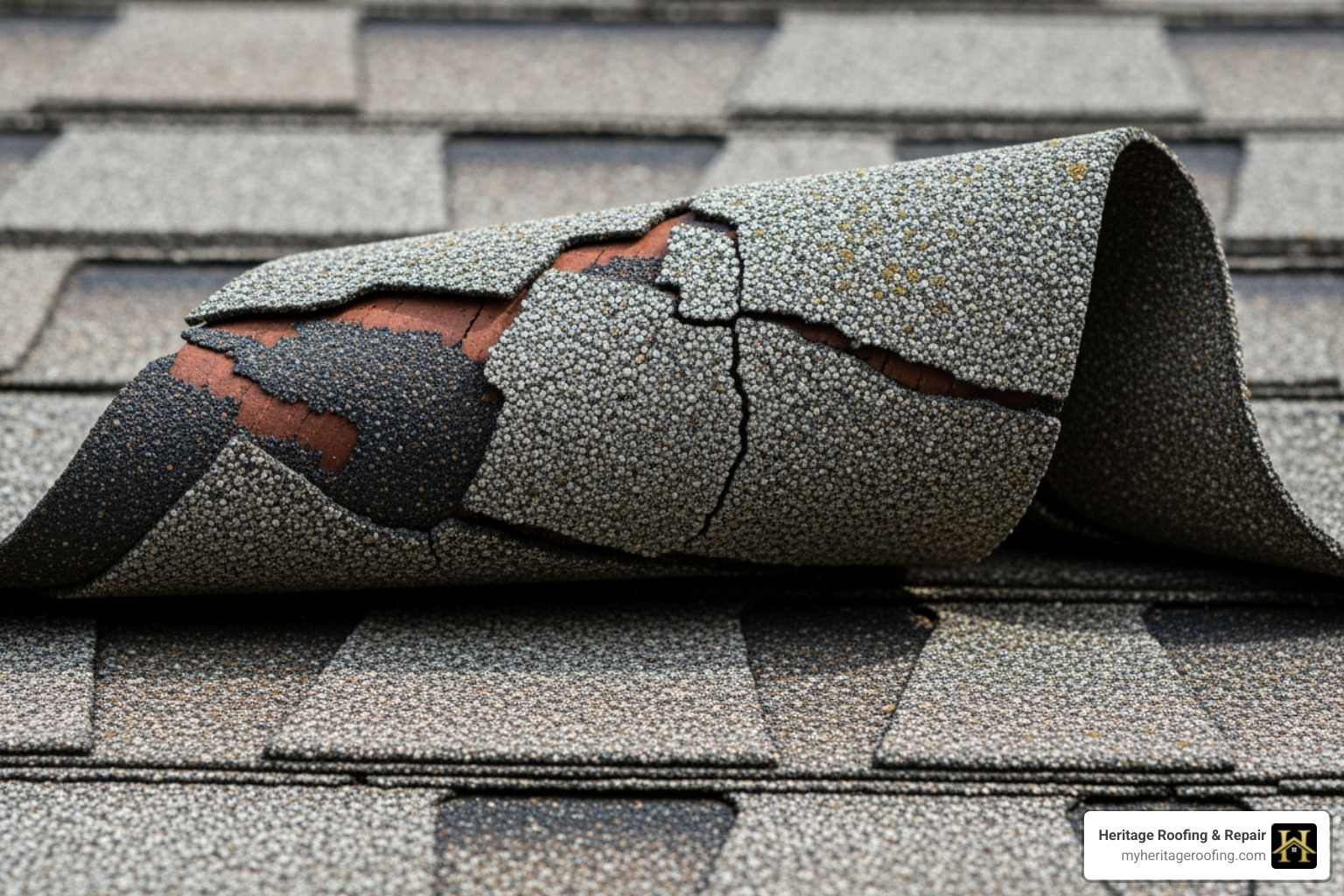
If you see multiple warning signs or your roof is approaching the end of its lifespan, a professional roof inspection can provide a clear picture of its condition and help you plan your next steps.
When deciding whether to repair or replace, consider the extent of the damage and the roof’s age. If the damage is minor, localized, and your roof is relatively young (less than 10 years old), a repair might be sufficient. However, for widespread damage, an older roof, or if the cost of repairs approaches the cost of a full replacement, a new roof is often the smarter long-term investment.
Budgeting for Your New Roof: Cost Factors and Material Options
The cost of a roof replacement for homeowners can vary significantly based on several key factors. Understanding these variables will help you create a realistic budget and choose the best materials for your home and climate. The average cost of replacing a roof is around $9,520, but this can fluctuate widely. Let’s break down what influences this investment.
Here are the key factors that determine the cost of your roof replacement:
- Roof Size: This is straightforward – a larger roof requires more materials and labor, increasing the overall cost.
- Roof Complexity and Pitch: A roof with multiple peaks, valleys, dormers, or a steep pitch is more challenging and time-consuming to work on. This complexity demands specialized equipment and additional safety measures, driving up labor costs.
- Material Selection: As we’ll discuss shortly, your choice of roofing material is one of the biggest cost drivers. Prices vary dramatically from basic 3-tab asphalt shingles to high-end slate or metal.
- Labor Costs: These vary by region and the complexity of the job. Highly skilled and certified installers command higher rates, but their expertise often translates to a longer-lasting, better-warranted roof.
- Debris Removal Fees: Tearing off an old roof generates a significant amount of waste. Dumpster rental and disposal fees are part of the overall project cost.
- Structural Material Replacement: If your roof inspection reveals damaged decking, rafters, or other structural components underneath the existing roof, these will need to be repaired or replaced, adding to the expense. Think of it like this: if you break your ankle, you don’t just get a cast; you also need crutches and possibly physical therapy. The same applies here.
- Workmanship Warranty Level: Higher-tier warranties often come with a slightly higher upfront cost but provide extended protection and peace of mind.
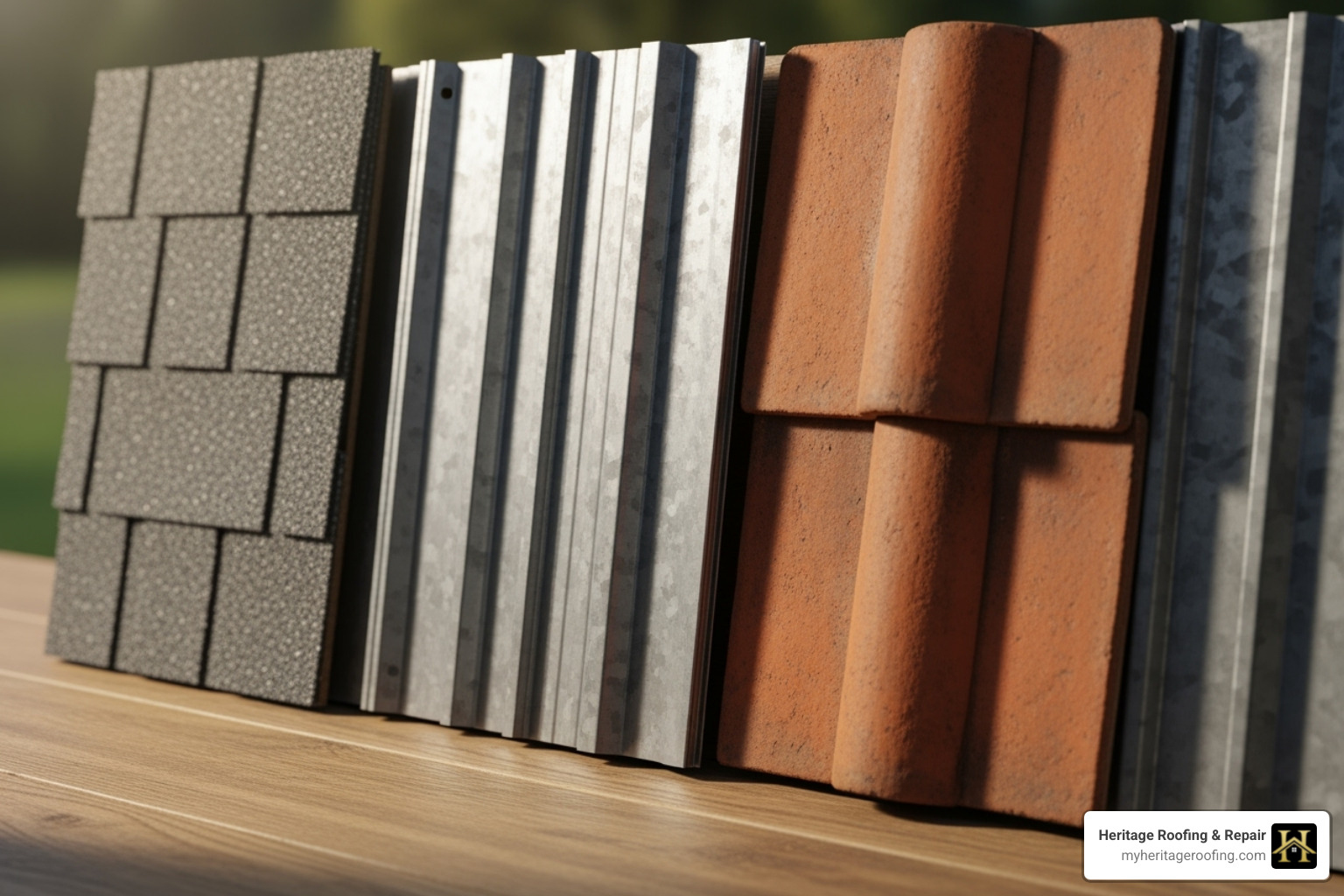
Material Options for Your Roof Replacement
Choosing the right material is about balancing aesthetics, durability, and budget. Asphalt shingles are the most popular choice in North America due to their affordability and versatility, but metal and tile offer longer lifespans and unique benefits. Here’s a quick comparison of common materials:
| Material Type | Average Cost (Installed) | Average Lifespan | Key Benefits |
|---|---|---|---|
| 3-Tab Asphalt Shingles | $7,300 – $10,600 | 15-18 years | Most affordable, widely available, easy to install. |
| Architectural Shingles | $11,200 – $17,100 | 20-30 years | More durable, better wind resistance, dimensional look. |
| Upgraded Architectural | $13,100 – $19,000 | 30-50 years | Improved durability, premium aesthetics, long warranties. |
| Standing Seam Metal | $27,500 – $42,300 | 40-70 years | Extremely durable, energy-efficient, fire-resistant. |
| Spanish Tile | $33,700 – $69,800 | 50-100+ years | Highly durable, distinctive aesthetic, ideal for hot climates. |
| Composite Slate | Comparable to high-end architectural | 50+ years | Mimics natural slate, lightweight, eco-friendly. |
For more details on specific options, explore our pages on Asphalt Shingles, Metal Roofing, Tile Roofing, and Composite Slate.
Financing Your Roof Replacement
If a new roof isn’t in your immediate budget, don’t worry. There are several ways to finance the project without draining your savings, from insurance coverage for storm damage (which we’ll cover next) to dedicated financing plans.
- Insurance Coverage: As you’ll see, if your roof damage is caused by a covered peril like a storm, your homeowners insurance can significantly reduce or even cover the cost.
- Home Equity Loans/HELOCs: These allow you to borrow against the equity in your home, often at favorable interest rates.
- Personal Loans: Unsecured personal loans can provide quick access to funds, though interest rates may be higher.
- Contractor Financing: Many reputable roofing companies, including us, offer financing options directly or through third-party lenders. These can sometimes include promotional periods with low or no interest.
We understand that a roof replacement for homeowners is a significant investment. That’s why we offer flexible roofing financing options to help make your project affordable.
Why Understanding Your Roof Replacement Options Matters
Roof replacement for homeowners is more than just picking new shingles – it’s a major decision that affects your home’s safety, value, and your family’s comfort for decades to come. The average asphalt shingle roof lasts only 15 to 18 years, and many homeowners underestimate their roof’s age, costing insurers $1.31 billion annually in lost premiums.
Key considerations for homeowners planning a roof replacement:
- Cost factors: Size, materials, complexity, and labor typically range from $6,700 to $80,000
- Material options: Asphalt shingles ($7,300-$10,600), metal roofing ($27,500-$42,300), or tile ($33,700-$69,800)
- Insurance coverage: Storm damage may be fully covered under Replacement Cost Value (RCV) policies
- Contractor selection: Choose licensed, local roofers with manufacturer certifications
- Timeline: Plan for moderate weather seasons to avoid installation issues
Whether you’re dealing with storm damage, aging shingles, or persistent leaks, understanding your options helps you make informed decisions and avoid costly mistakes. This guide covers everything from recognizing warning signs to navigating insurance claims and choosing the right contractor for your professional roof replacement.
I’m Rex Wisdom, owner of Heritage Roofing & Repair, and for over 50 years, my family has helped homeowners throughout Northwest Arkansas steer roof replacement for homeowners with honest advice and quality craftsmanship. Whether you’re facing storm damage or planning an upgrade, we’ll walk you through every step of the process to ensure your investment protects your home for years to come.
Roof replacement for homeowners terms made easy:
- average roof replacement cost
- best residential roofing replacement services
- best residential roof replacement
Is It Time for a New Roof? 7 Telltale Signs to Watch For
Knowing when to repair versus replace your roof starts with a careful inspection. While a minor issue might be a simple fix, multiple problems or advanced age often point toward a full replacement. The average life expectancy of the most common type of roof, the 3-tab asphalt shingle, is only 15 to 18 years. If your roof is approaching that age, it’s time to pay close attention.
It’s easy to overlook your roof, as it’s often out of sight, out of mind. However, neglecting its condition can lead to far more expensive problems down the line, such as water damage, mold, and structural issues. Regular maintenance and knowing what to look for can save you significant time, money, and stress. If you’re unsure, a professional roof inspection can provide clarity.
Here are seven clear warning signs that a roof replacement for homeowners might be on the horizon:
- Curling or Cracked Shingles: Shingles that are curling at the edges, cupping in the middle, or showing visible cracks are signs of wear and tear, often due to age and sun exposure. This compromises their ability to shed water effectively.
- Missing Shingles: Strong winds can lift and tear off shingles, leaving your roof decking exposed to the elements. Even a few missing shingles can lead to significant leaks and further damage.
- Granules in Gutters: For asphalt shingles, the protective granules on their surface protect them from UV rays. If you find a significant amount of these granules collecting in your gutters, it indicates that your shingles are deteriorating and losing their effectiveness.
- Ceiling Leaks or Water Stains: These are undeniable indicators of a roof problem. Water stains on your attic ceiling, walls, or even dripping water suggest that your roof’s protective layers have been compromised.
- Sagging Roof Deck: A sagging roof deck is a serious structural issue that could indicate rot in the decking or rafters, often caused by prolonged moisture exposure. This requires immediate attention and almost always a full replacement.
- Widespread Moss or Algae: While some green growth can be cleaned, extensive moss or algae growth, especially if it’s thick or causing shingles to lift, can trap moisture against your roof’s surface and lead to premature deterioration.
- Roof Age: As mentioned, if your asphalt shingle roof is 15-18 years old or older, even if it looks okay from the ground, its protective qualities are likely diminishing. An older roof is more susceptible to damage and less likely to be fully covered by insurance.
When deciding whether to repair or replace, consider the extent of the damage and the roof’s age. If the damage is minor, localized, and your roof is relatively young (less than 10 years old), a repair might be sufficient. However, for widespread damage, an older roof, or if the cost of repairs approaches the cost of a full replacement, a new roof is often the smarter long-term investment.
Budgeting for Your New Roof: Cost Factors and Material Options
The cost of a roof replacement for homeowners can vary significantly based on several key factors. Understanding these variables will help you create a realistic budget and choose the best materials for your home and climate. The average cost of replacing a roof is around $9,520, but this can fluctuate widely. Let’s break down what influences this investment.
Here are the key factors that determine the cost of your roof replacement:
- Roof Size: This is straightforward – a larger roof requires more materials and labor, increasing the overall cost.
- Roof Complexity and Pitch: A roof with multiple peaks, valleys, dormers, or a steep pitch is more challenging and time-consuming to work on. This complexity demands specialized equipment and additional safety measures, driving up labor costs.
- Material Selection: As we’ll discuss shortly, your choice of roofing material is one of the biggest cost drivers. Prices vary dramatically from basic 3-tab asphalt shingles to high-end slate or metal.
- Labor Costs: These vary by region and the complexity of the job. Highly skilled and certified installers command higher rates, but their expertise often translates to a longer-lasting, better-warranted roof.
- Debris Removal Fees: Tearing off an old roof generates a significant amount of waste. Dumpster rental and disposal fees are part of the overall project cost.
- Structural Material Replacement: If your roof inspection reveals damaged decking, rafters, or other structural components underneath the existing roof, these will need to be repaired or replaced, adding to the expense. Think of it like this: if you break your ankle, you don’t just get a cast; you also need crutches and possibly physical therapy. The same applies here.
- Workmanship Warranty Level: Higher-tier warranties often come with a slightly higher upfront cost but provide extended protection and peace of mind.
Material options for your roof replacement for homeowners
Choosing the right material is about balancing aesthetics, durability, and budget. Asphalt shingles are the most popular choice in North America due to their affordability and versatility, but metal and tile offer longer lifespans and unique benefits. Here’s a quick comparison of common materials:
| Material Type | Average Cost (Installed) | Average Lifespan | Key Benefits |
|---|---|---|---|
| 3-Tab Asphalt Shingles | $7,300 – $10,600 | 15-18 years | Most affordable, widely available, easy to install. |
| Architectural Shingles | $11,200 – $17,100 | 20-30 years | More durable, better wind resistance, dimensional look. |
| Upgraded Architectural | $13,100 – $19,000 | 30-50 years | Improved durability, premium aesthetics, long warranties. |
| Standing Seam Metal | $27,500 – $42,300 | 40-70 years | Extremely durable, energy-efficient, fire-resistant. |
| Spanish Tile | $33,700 – $69,800 | 50-100+ years | Highly durable, distinctive aesthetic, ideal for hot climates. |
| Composite Slate | Comparable to high-end architectural | 50+ years | Mimics natural slate, lightweight, eco-friendly. |
For more details on specific options, explore our pages on Asphalt Shingles, Metal Roofing, Tile Roofing, and Composite Slate.
Financing Your Roof Replacement
If a new roof isn’t in your immediate budget, don’t worry. There are several ways to finance the project without draining your savings, from insurance coverage for storm damage (which we’ll cover next) to dedicated financing plans.
- Insurance Coverage: As you’ll see, if your roof damage is caused by a covered peril like a storm, your homeowners insurance can significantly reduce or even cover the cost.
- Home Equity Loans/HELOCs: These allow you to borrow against the equity in your home, often at favorable interest rates.
- Personal Loans: Unsecured personal loans can provide quick access to funds, though interest rates may be higher.
- Contractor Financing: Many reputable roofing companies, including us, offer financing options directly or through third-party lenders. These can sometimes include promotional periods with low or no interest.
We understand that a roof replacement for homeowners is a significant investment. That’s why we offer flexible roofing financing options to help make your project affordable.
Will Insurance Pay? Navigating the Claims Process for a Storm-Damaged Roof
Many homeowners are surprised to learn their insurance may cover a full roof replacement for homeowners if the damage is from a covered event like hail or high winds. Navigating the claims process can be tricky, but documenting damage and understanding your policy are the keys to a successful claim.
After a storm, it’s crucial to document everything safely. Take photos of missing or creased shingles, dents on gutters or vents, and any other “collateral damage” that proves the storm’s intensity. Before calling your insurer, have a qualified roofer perform an inspection. A professional assessment strengthens your claim and ensures no damage is missed.
We highly recommend having your roofing contractor present when the insurance adjuster inspects your property. Adjusters can miss subtle damage, and your contractor can advocate on your behalf to ensure a complete and fair assessment. Our team specializes in roof insurance claims and can guide you through the entire process, from initial filing to handling supplements for additional damage found later.
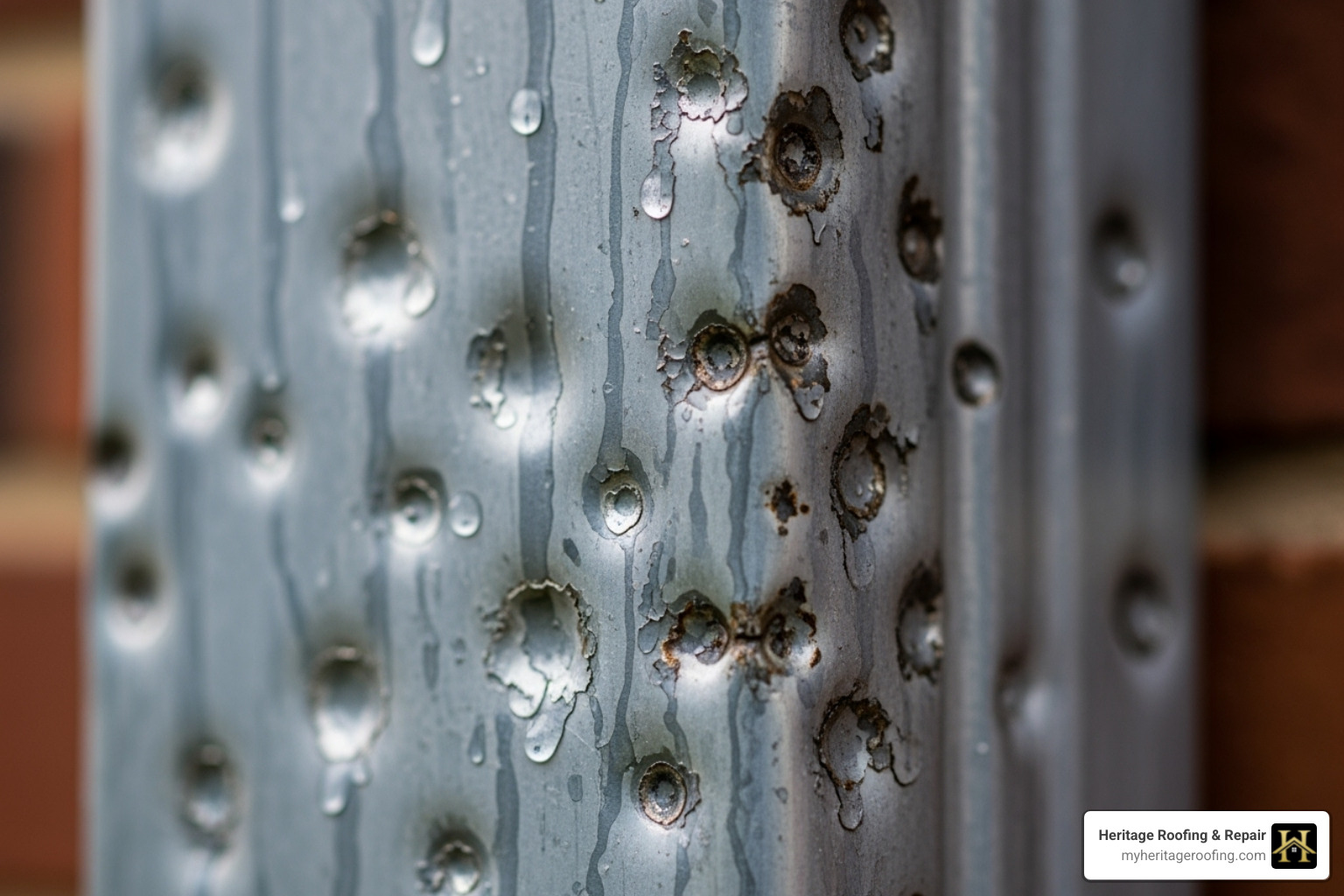
ACV vs. RCV: Understanding Your Insurance Policy
Whether insurance covers the full cost depends on your policy type.
- Actual Cash Value (ACV) policies pay the depreciated value of your roof. If your 10-year-old roof is damaged, you’ll only receive what it’s worth today, leaving you to pay the difference for a new one.
- Replacement Cost Value (RCV) policies are the gold standard. They cover the full cost to replace your roof with new materials at current prices, minus your deductible.
Your roof’s age and your deductible amount also play a significant role, so review your policy before you need it.
What to Do if Your Roof Insurance Claim is Denied
A denied claim isn’t the final word. Start by reviewing the denial letter to understand the reason. If the issue is insufficient evidence or a disagreement on the cause of damage, you have options:
- Gather more evidence with a detailed inspection from your contractor.
- Request a second inspection from a different insurance adjuster.
- Hire an independent appraiser to provide an unbiased assessment.
- File a formal appeal with your new documentation.
Persistence and thorough documentation, with the help of an experienced storm damage roof repair contractor, can often lead to a successful appeal.
The Ultimate Guide to Hiring a Contractor for a Roof Replacement for Homeowners
Choosing the right contractor is the most critical decision for your roof replacement for homeowners project. A skilled, trustworthy roofer protects your home’s value and your family’s safety. The difference between a quality installation and a shoddy one can mean a roof that lasts 30 years versus one that fails in 10.
When vetting potential contractors, look for:
- A Strong Local Presence: A contractor with deep roots in your community understands local weather challenges, is familiar with building codes, and has a reputation to uphold. They can’t disappear after the job is done.
- Positive Reviews and References: Check online reviews on Google and the BBB, but also ask for and call references from recent customers.
- Proper Credentials: Verify they have the necessary licensing for your area (check state-by-state roofer license requirements), general liability insurance, and worker’s compensation coverage.
- Manufacturer Certifications: Certifications from brands like GAF, Owens Corning, or CertainTeed indicate specialized training and allow the contractor to offer improved warranties.
- Detailed Written Estimates: Get at least three quotes that clearly outline all costs, materials, and timelines. This helps you spot red flags and understand fair market pricing.
How to Avoid Scams and Find a Trustworthy Local Roofer
After major storms, “storm chaser” contractors often appear, promising quick, cheap work. These out-of-state companies frequently deliver subpar results and are gone when problems arise. Be wary of these red flags:
- \”Free Roof\” Promises: Any offer to waive your insurance deductible is a form of insurance fraud. You are legally responsible for your deductible.
- High-Pressure Tactics: A reputable contractor will give you time to make a considered decision. Don’t be rushed into signing a contract on the spot.
- Suspiciously Low Bids: An estimate that is dramatically lower than others often indicates inferior materials, uninsured labor, or cut corners.
- Large Upfront Payments: A reasonable deposit is standard, but demanding full payment upfront or only accepting cash is a major warning sign.
For over 50 years, our company has built its reputation on honest, transparent service to our neighbors in Northwest Arkansas. Trust is earned through consistent quality and standing behind our work.
Finding a Reputable Roofer in Berryville, AR
Choosing a local contractor in Northwest Arkansas means choosing a team that understands our region’s unique weather, from hailstorms to ice. A local company is accountable to the community it serves.
Heritage Roofing & Repair
3458 Arkansas State Hwy 221, Berryville, AR 72616
(870) 654-1164
More Than Just Shingles: Key Components of a Lasting Roof
When planning a roof replacement for homeowners, a roof is a complex system. While shingles are the visible part, several other layers work together to protect your home. A professional installation ensures every component functions correctly for maximum longevity.
Key components of a complete roofing system include:
- Roof Decking: The plywood or OSB foundation that supports the entire system.
- Underlayment: A water-resistant barrier that acts as a secondary line of defense.
- Ice and Water Shield: A waterproof membrane installed in vulnerable areas like valleys and eaves to prevent damage from ice dams.
- Flashing: Metal pieces that direct water away from joints around chimneys, vents, and skylights.
- Drip Edge: A metal strip along the roof’s edge that guides water into the gutters.
- Starter Strips: The first row of shingles that provides a crucial seal against wind uplift.
- Ridge Cap Shingles: Thicker shingles used to cover the roof’s peaks.
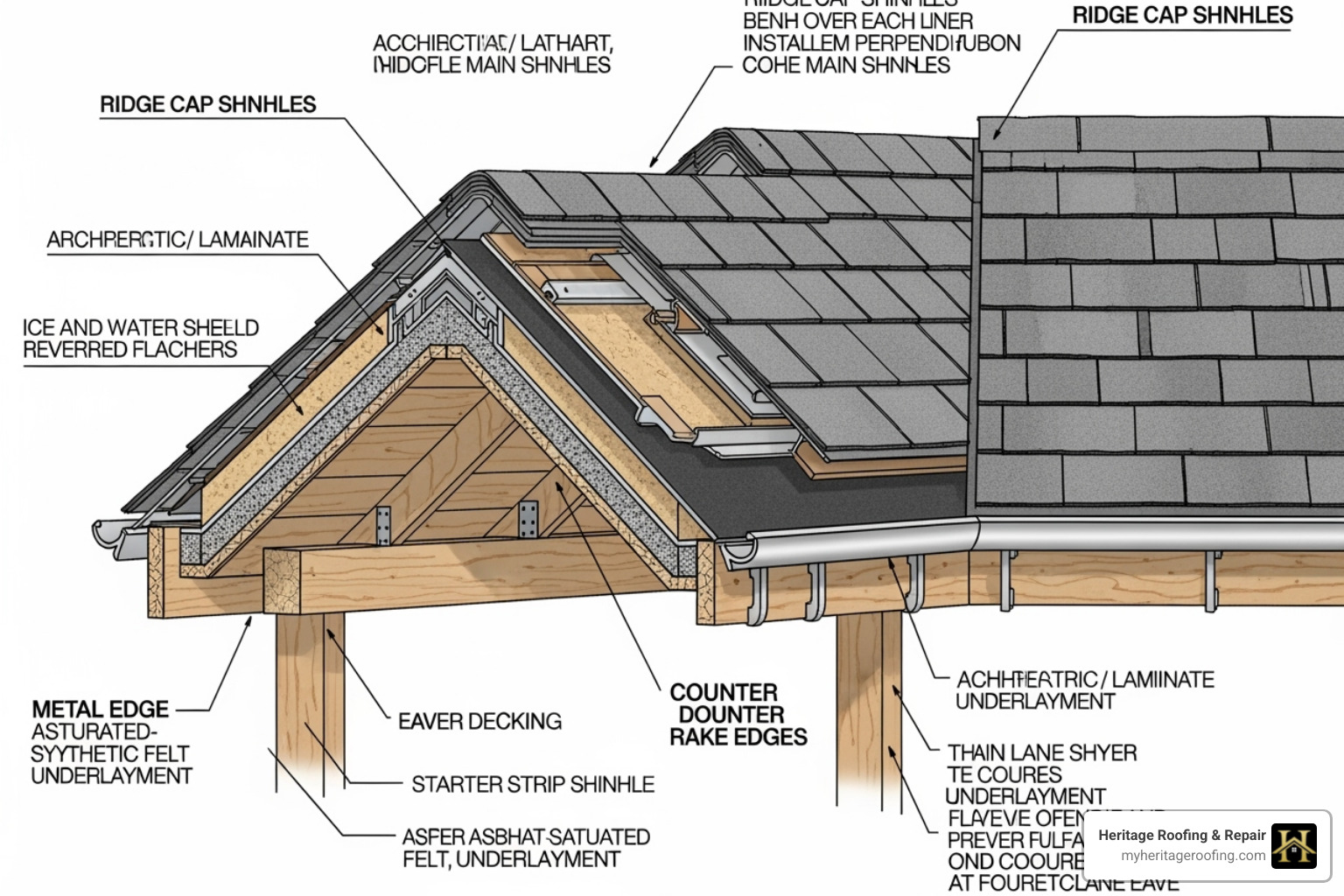
The Critical Role of Roof Ventilation
Proper ventilation is essential to your roof’s health and can double its lifespan. An attic needs to breathe to release trapped heat and moisture. In the summer, extreme heat can \”cook\” shingles from below, causing them to age prematurely. In the winter, moisture can condense and lead to mold and rot. A balanced system of intake (soffit) and exhaust (ridge) vents protects your roof and can even lower your energy bills.
Understanding Your Roofing Warranties
A quality roof replacement comes with two warranties: a material warranty from the manufacturer against defects and a workmanship warranty from your contractor covering the installation. Here’s where manufacturer certifications from companies like GAF, Owens Corning, or CertainTeed become valuable. Certified installers can offer improved system warranties that cover both materials and labor, providing superior, long-term protection. Always ask if a warranty is transferable, as this can be a strong selling point if you sell your home.
Your New Roof: A Smart Investment in Your Home’s Future
Congratulations on learning what it takes to manage a roof replacement for homeowners. While it’s a major project, you are now equipped with the knowledge to make confident decisions. A new roof is more than just protection; it’s a smart financial investment that can increase your home’s value by an average of $12,000 to $15,000, lower energy bills, and provide invaluable peace of mind.
Success lies in spotting the warning signs early, understanding your material and budget options, and, most importantly, choosing a trustworthy local contractor. The lowest bid is rarely the best value. What matters is finding a contractor with deep community roots, proper credentials, and a proven track record.
For homeowners throughout Northwest Arkansas, our team at Heritage Roofing & Repair brings over 50 years of trusted experience to every project. We understand our region’s weather and build roofs designed to last. We’re your neighbors, and we’ll be here to honor our warranties for years to come.
Don’t wait for the next storm to start planning. The sooner you begin, the more flexibility you’ll have in scheduling your project. Take the next step to secure your home’s future.
Ready to get started? Schedule your professional roof replacement today and let our experienced team guide you through the process. Your home deserves the best protection.
